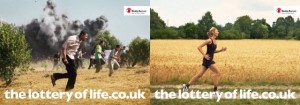
Picture yourself going about your daily routine. Perhaps you woke up for a morning jog in the humid morning air of suburbia, went fishing to unwind after a long day of work, or jumped into the lake to cool off with some of your closest friends. Now picture the same landscape: the trees, the water, the fields around you, but now there are bomb shells exploding within feet of you. Citizens carry guns through the streets, poised and ready to defend themselves against the next strike from the enemy. Men, women, and children jump from the frameworks of what were once shops and houses into the flooded streets below, desperately trying to salvage what little has survived the terrible natural disaster in order to subsist until aid comes. In the “Lottery of Life” ad campaign, the juxtaposition of these images (the calm, prosaic lives of suburban dwellers in Sweden and the treacherous, unpredictable existence of those in war-torn countries like Syria, Lybia, and Egypt) communicates a message that resonates powerfully with the viewer. It claims that the world and its people are all essentially the same, but we were placed in the “lottery” of life and ended up in either very secure or very troubling circumstances. The point of the advertisements is not necessarily to solicit donations; it is more to raise awareness about the state of affairs in these other countries. Through the use of various rhetorical devices such as commonplaces, pathos, and kairos, the ad persuades the viewer to join the effort in changing the status quo of violence and squalor in developing and third-world countries.
The commonplace in the “Lottery of Life” ad campaign is the depiction of activities that are part of a daily routine or that are just fun and relaxing activities that the average person would partake in. In and of themselves, these pictures of a woman running and a boy fishing do not hold any persuasive value. However, when placed directly next to images of men running away from explosions in the background and a small boy holding a gun, the similarities and differences between the two situations become all too evident. It helps the viewer to relate directly to the situations at hand. Particularly in the image of the woman running and the men running away from an explosion, the landscape almost appears to seamlessly flow together, as if trying to show that the woman too is running away from the explosion. The ad wants us to acknowledge that we are all the same people, just placed in fundamentally similar situations with fundamentally disparate demons to battle. This commonplace correlates perfectly with the pathos in the campaign, which uses these shared activities and settings to formulate an emotional appeal to the viewer.
Pathos, derived from the stark contrast between the situations in the two juxtaposed pictures, is a pivotal part of the marketing ploy utilized here as it is meant to evoke sympathy from the viewer and thus motivate them to action. The viewer can empathize (somewhat) with the situation in the third-world countries because of the strikingly similar landscapes in both pictures. In the picture of the running men and the running woman, both pictures have wheat-colored fields dotted with green trees. It makes the viewer wonder, “Could that have been me?”. According to the campaign, it would appear that the viewer had a 50-50 shot of either maneuvering minefields or simply maneuvering traffic. It is a scary consideration as we lead our lives, that we each were one coin toss away from having to literally fight for survival every day. Therefore, the viewer feels a sense of guilt. Knowing that they could have been in the same situation, they feel the need to become more aware of the situation at hand. The emotional appeal is apparent as the viewer recognizes how fortunate he or she is for having “dodged the bullet” of having to dodge bullets, and thus realizes his or her responsibility to his or her counterparts in these developing countries. However, the pathos of the advertisement would not be nearly as effective if the timing of the situation were not as kairotic.
Kairos is instrumental in appropriately conveying the desired message in the “Lottery of Life” ad campaign. Recently, the media has been flooded with stories about unrest in Egypt, attacks at Benghazi, and violent religious conflicts in the Middle East. There is no better time to raise awareness of the severity of these situations than right now. As we watch these news stories from the safer side of a TV screen, we feel so distant and disconnected from the events. The most horrific of transgressions may only elicit a momentary concern from a viewing audience. By releasing the “Lottery of Life” advertisements right after these events have transpired and by relating them directly to the viewer through the similar landscapes in the pictures, the viewer no longer feels disconnected. Rather, the viewer feels a sense of immediacy, the recognition that those poor families desperately struggling to survive in the midst of a flood or fighting a war could be them. The opportune time to use this tactic is right after such an instance comes up, and with the constant military strikes in Egypt, Libya, and Syria, we must do something as soon as possible to help our fellow man before our fellow man is eradicated. This is the message that this campaign imparts, and is one that would not be as forceful if it were not placed at a kairotic moment in time.
Through the tactful use of rhetorical devices such as commonplaces, pathos, and kairos, the “Lottery of Life” campaign effectively raises awareness of the hazardous conditions in developing countries by relating these dangerous situations to the viewer’s own circumstances. The commonplace, the fairly mundane activities such as running and fishing, ties into the pathos in the advertisement wonderfully. While the commonplace initially helps to catch the viewer’s attention, the pathos maintains the reader’s attention by juxtaposing these relatively banal activities with more intense and life-threatening activities in similar settings. The emotional appeal is derived from this comparison and seems to be very effective despite its modesty. However, the commonplaces and the pathos would not be nearly as compelling if the kairos of the situation were not as pertinent. The discord in countries deeply ensnared in civil wars and power struggles is an increasingly relevant topic, and this campaign brings it to the forefront of the public’s attention. The sensationalized versions of these precarious situations that have suffused the media only work to further detach the viewing audience from these people in war-torn countries who are so similar to us. By utilizing the juxtaposition of these pictures, the “Lottery of Life” campaign serves to bridge the gap between us and the residents of these third-world countries and helps us to raise awareness of how we can help in such a situation. Overall, the campaign is very successful, and despite its lack of words, it speaks volumes to the viewers who up until now have been complacent in their own situation and hopefully will rouse them to action. We, who have been blessed with so much in the lottery of life, must recognize our blessings and work to help these people who are in increasingly dangerous circumstances.





